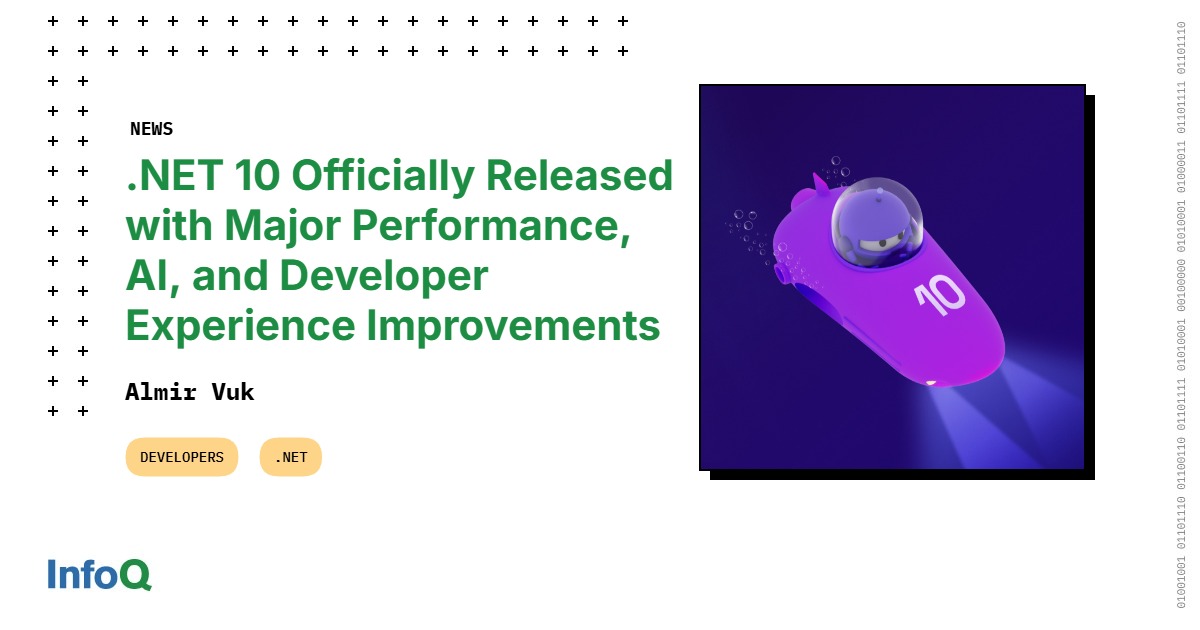Microsoft announced the general availability of .NET 10, describing it as the most productive, modern, secure, and high-performance version of the platform to date. As stated by the company, the release is the result of a year-long effort involving thousands of contributors. It includes improvements across the runtime, libraries, languages, tools, frameworks, and workloads.
According to Microsoft, the update continues the goal of offering a unified platform that supports traditional development and modern AI-focused scenarios.
As reported, .NET 10 delivers notable runtime and compiler optimizations. These include enhancements to the JIT compiler, new hardware acceleration paths such as AVX10.2 and Arm64 SVE, and improvements to NativeAOT that reduce size and startup time.
Loop inversion, stack allocation strategies, and write-barrier changes also contribute to measurable reductions in memory usage and GC pauses. Microsoft highlighted these improvements as key factors behind what it calls the fastest .NET release so far.
Regarding the programming languages, C# 14 and F# 10 ship alongside the release. C# 14 introduces field-backed properties, new span conversions, the null-conditional assignment operator, collection expression extensions, partial constructors, and ref struct interface support, with Microsoft emphasizing cleaner and more maintainable code.
F# 10 focuses on clarity and performance, adding scoped warning controls, improved property accessors, struct-based optional parameters, enhanced tail-call support, and a preview of parallel compilation. Improvements in task expressions, type checking, and trimming aim to offer a smoother everyday development experience.
As stated by Microsoft, .NET Libraries receive updates across cryptography, networking, diagnostics, and serialization. The release expands post-quantum cryptography support, adds a simplified WebSocketStream API, brings TLS 1.3 support to macOS, and reduces allocations across HTTP and socket operations. JSON serialization gains safety improvements and additional configuration options, while cryptography APIs add new standards-aligned capabilities.
.NET Aspire 13 ships together with .NET 10 as a cloud-native application framework. According to the announcement, with a new name, just “Aspire”, in this release, it strengthens orchestration for front ends, APIs, containers, and data stores, with improvements in development workflows, deployment performance, and multi-language integration.
The update adds simplified templates, new resource types, enhanced security options, and dashboard improvements, along with expanded support for coordinating Python, JavaScript, and other non-.NET services from a unified AppHost.
AI-focused capabilities also expand through the Microsoft Agent Framework, Microsoft.Extensions.AI, and first-class Model Context Protocol (MCP) support. As reported, these systems aim to standardize patterns for building agentic workflows, integrating external tools, enabling telemetry, and working across multiple AI providers. According to Microsoft, the goal is to simplify the construction of intelligent, multi-agent applications while maintaining consistency with existing .NET development practices.
Furthermore, the release brings significant updates across ASP.NET Core, Blazor, .NET MAUI, and Entity Framework Core 10. Web developers gain improved security, diagnostics, OpenAPI 3.1 support, stronger form validation, passkey authentication, and NativeAOT enhancements. Blazor adds better state persistence, improved resilience, optimized loading, and expanded JavaScript interop.
.NET MAUI introduces new platform bindings, performance improvements, updated controls, and XAML enhancements. EF Core 10 adds vector search support, native JSON handling, new LINQ capabilities, and improved complex type mapping to support modern workloads, including AI-powered scenarios.
The .NET 10 SDK also includes notable CLI enhancements, new testing capabilities, container image options, and the new SLNX solution format.
Regarding the support, as confirmed by Microsoft, .NET 10 is a Long-Term Support (LTS) release and will receive three years of updates until November 10, 2028.
Early community reactions, as observed in public comments, highlight both enthusiasm and practical concerns. Several developers praised the performance improvements, with one user describing .NET 10 as “really awesome and so much faster.” Others raised questions about tooling support, particularly regarding Visual Studio 2026 and its availability alongside .NET 10. Some users noted confusion caused by the download page layout, while others asked whether Visual Studio 2022 would continue to support .NET 10 workloads.
Feedback also included requests for broader adoption within Microsoft’s own product teams, including calls for the Office team to move beyond .NET Framework 4.8 for VSTO development. Additional comments referenced interest in new features such as WebSocketStream availability via NuGet, future C# language enhancements including union types, and clarifications around Aspire credentials. A few users also shared platform-specific limitations, such as macOS restrictions affecting HTTPS interception.
Collectively, the feedback reflects strong interest in the release and ongoing expectations for tooling clarity, platform support, and future language evolution.
For interested readers, full release notes are available in the official documentation.










